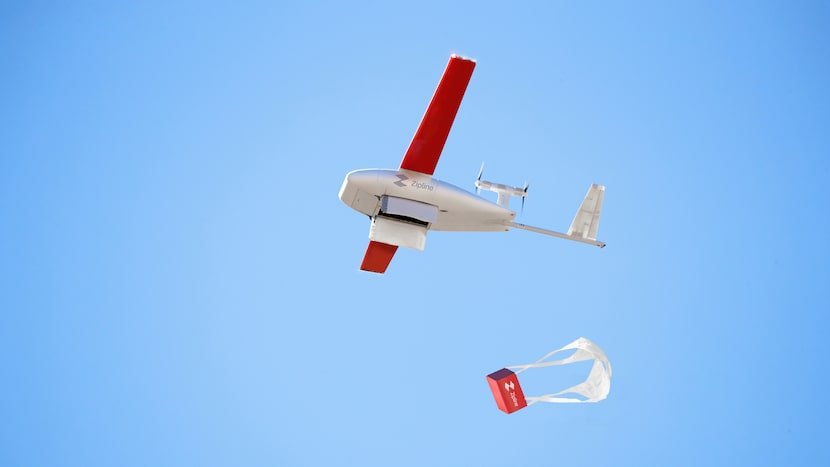Drone technology has taken North Texas by storm.
It’s popularity has become far-reaching across the U.S. and world. But in Dallas-Fort Worth, they can be used for personal uses or even grocery delivery.
In July, the Federal Aviation Administration officially authorized commercial drone flights without visual observers in the Dallas area. California-based Zipline has made more than 1 million deliveries in the last 3 years alone, some in North Texas. The company is building a local operations and maintenance hub in D-FW, and is hiring for a variety of local roles including technicians, controllers and community engagement leaders.
The Dallas Morning News sat down with Keller Rinaudo Cliffton, CEO and co-founder of Zipline.
Tell us a little bit more about Zipline and your start at the company.
My and my co-founders’ backgrounds were in robotics, automation, autonomy and we just got really excited about logistics. It seemed like it would be possible to build an automated logistics system for Earth over the next decade. The thing that was really exciting to us about that was that logistics only really does a good job of serving the golden billion humans on Earth — 7 billion people whose access either sucks or is nonexistent. So we thought, “Hey, if we can build a new kind of logistics system, it would be 10 times as fast, half the cost, zero-emission. It would also be possible to build the first logistic system to serve adult people equally.” That was the original vision we had in 2013. It was obviously incredibly naïve. We didn’t at all appreciate how difficult any of it would be but that’s what we started.
Three years later, we launched our first commercial service in Rwanda.
What’s your footprint like in North Texas? What do you see in the area?
One of the exciting things is Zipline operated outside the U.S. for the first eight years of the company’s history. We’ve seen in the last three years, the FAA starts saying that it is really important, that the U.S. actually leads the way in this rapidly growing industry. It’s not only going to save lives, but also reduce emissions and make delivery cheaper for all consumers. So in November, Zipline became the first company in U.S. history to be given full permission to fly commercially in the U.S. by the FAA. That was a huge milestone. That’s a national approval.
For Zipline, we have to select metros based on a lot of different characteristics. And we’re launching metro by metro in the U.S. We can’t just turn infrastructure on in every city in the U.S. simultaneously. Dallas is the first metro that Zipline is investing in and launching in, and that’s for wide variety of reasons. We think it’s fastest growing metros in the United States. Amazing, super business-friendly. We’ve been working with so many different municipalities that are, frankly, really into this technology and are really excited to lead the country by helping turn Dallas more into like a technology and innovation hub and a role model that every other state in the U.S. is eventually going to follow. I think all of these things combined, there’s also businesses that Zipline actually has contracts with and is serving in Dallas… We’re investing almost exclusively in Dallas over the next eight months to really scale things up before we then start investing in other metros in the U.S. It’s pretty new. It’s awesome, we love Dallas, and I’m gonna be spending a lot of time there personally over the next eight months.
How would the average person notice Zipline in Dallas-Fort Worth?
We spent the last eight years scaling this fixed-wing platform.
Platform 2 is designed based on all the learnings we’ve had from serving Walmart so far and from doing home delivery. Platform 2 is designed. We’ve been investing in this product for the last three years for delivery in the U.S. That is the core focus. The way Platform 2 works is that we can show up and integrate onto the side of any existing building in 24 hours and then enable teleportation from that building to any home within range. It’s a very simple concept of operations. You can kind of think of it as showing up and installing, like, an AC unit or an EV charger onto the side of the building. Now that that’s installed, the least about it is they just think of it as a magical sci-fi portal in the wall of the building. We are literally just building this pool portal in the wall.
Now any Walmart associate or any partner [like], Cleveland Clinic, Mayo Clinic, SweetGreen, Mendocino Farms, can get an order, put something in a box, then they just pass it through the magical portal, and there’s no human in the loop. Once the product is loaded, we are basically loading that product automatically … We can deliver quietly, with dinner plate-level precision, to any home. This works pretty much equally well for like apartment buildings, hotels, duplexes. We can deliver in a way that’s half the cost of this and delivered today and fully zero emission, which is obviously a huge improvement, using a 4,000 pound gas combustion vehicle driven by a human to deliver something to you that weighs on average five pounds.
If someone places a delivery, how long does it take?
It’s about 10 times as fast.
Delivery that was going to take a normal instant delivery app, maybe 30 minutes to make, we can usually make it in three minutes. That was transformational for customers for a wide variety of reasons.
We have different use cases. We focus on healthcare, commerce and food. On the healthcare side, obviously, being able to get things in in three minutes is really valuable. If you wake up in the middle of night, you’re sick in bed, you’re not feeling well, you want something quickly. You don’t feel like want to get into your car and drive a little bit.
It’s also really valuable for a lot of our healthcare partners who are doing things like healthcare at home and hospital at home. I think a lot of people don’t realize but with the massive exponential growth of telepresence visits that came out of the pandemic. A lot of these hospital systems are now trying to figure out how they keep patients at home, rather than admit them into a hospital or bring them in for in person visit to cost everybody a lot more. So, a big part of healthcare at home and hospital at home is having the ability to deliver things directly to a home in just a couple minutes, even, potentially, while a patient is talking to a doctor on a phone.
Speed is important for healthcare and also really important for food. The quality rise and food is going to taste way better if it’s delivered fresh. You’re basically having in-restaurant experience at home, in a way that instant delivery just does not. I think everybody’s used to it at this point, but you get food that’s like, soggy.
Texas is a testing ground to a lot of autonomous driving and other technologies that can be viewed as eliminating jobs. What’s your take?
If you look throughout history, that has been said of practically every major technology that’s been invested over the last 150 years. There are certain cases where people were like, ‘Oh, you know, street lamps, electric street lamps, are going to replace all the people who had to go and clean them.’ The lamp cleaners that wiped the lamps because they used to burn with oil. Now we won’t need those people. But there’s a lot of innovation. For example, people said ATMs were going to eliminate bank tellers. They are a million ATMs in the U.S., and there are also more bank tellers than when ATMs were invented.
[Technology is] allowing humans to be paid more money for the job, because the human can get more done. The reality is, from one distribution centers, we employ a lot of people at those facilities, it’s just that those are, like, high paying tech, empowered jobs, maintaining robots, commanding robots, rather than, like, we just pay the human herself to get on a motorcycle and spend four hours driving out for hospital to deliver something, and then four hours back. Now we keep her in one place, and she has robots that are sort of part of her team, and those robots are the ones doing the deliveries, and she’s responsible for loading the package into the robot, containing the robot, for all command interface in case something requires human intervention.
The other thing I would say one of these big delivery, food delivery apps in the U.S., for example, they are employing over a million human drivers a year. The average life cycle for one of those drivers is less than nine months. Pretty crazy labor situation. The way to think about it is that there are just not enough humans to do that and also it’s not a very good or high-paying job. The moment any human can find a better or higher paying job, they take it. Every nine months, we’re having to go hire another find another million people take this job. These are not like, high paying, stable jobs that are providing for like people’s abilities, like families or build wealth.
… These jobs become actually good, stable jobs that are more like robotics maintenance engineer. Instead of just driving the car all day long, you enable them to do a lot more.










